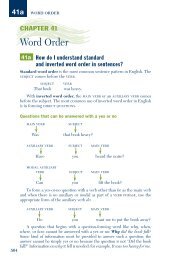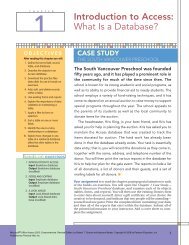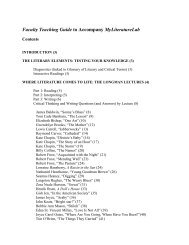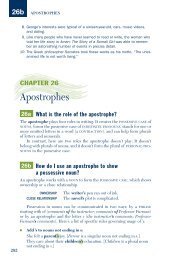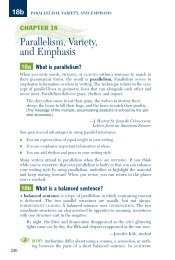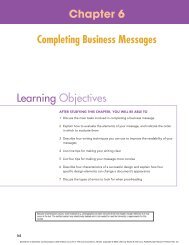JavaScript/JScript: Control Structures I - Pearson Learning Solutions
JavaScript/JScript: Control Structures I - Pearson Learning Solutions
JavaScript/JScript: Control Structures I - Pearson Learning Solutions
You also want an ePaper? Increase the reach of your titles
YUMPU automatically turns print PDFs into web optimized ePapers that Google loves.
2008934301<br />
Chapter 14 <strong>JavaScript</strong>/<strong>JScript</strong>: <strong>Control</strong> <strong>Structures</strong> I 399<br />
Outline<br />
14.1 Introduction<br />
14.2 Algorithms<br />
14.3 Pseudocode<br />
14.4 <strong>Control</strong> <strong>Structures</strong><br />
14.5 The if Selection Structure<br />
14.6 The<br />
14.1 Introduction<br />
Before writing a script to solve a problem, it is essential to have a thorough understanding<br />
of the problem and a carefully planned approach to solving the problem. When writing a<br />
script, it is equally essential to understand the types of building blocks that are available<br />
and to employ proven program construction principles. In this chapter and in Chapter 15,<br />
we discuss these issues in our presentation of the theory and principles of structured programming.<br />
The techniques you learn here are applicable to most high-level languages, including<br />
<strong>JavaScript</strong>.<br />
14.2 Algorithms<br />
if/<br />
else Selection Structure<br />
14.7 The while Repetition Structure<br />
14.8 Formulating Algorithms: Case Study 1 (Counter-<strong>Control</strong>led<br />
Repetition)<br />
14.9 Formulating Algorithms with Top-Down, Stepwise Refinement: Case<br />
Study 2 (Sentinel-<strong>Control</strong>led Repetition)<br />
14.10 Formulating Algorithms with Top-Down, Stepwise Refinement: Case<br />
Study 3 (Nested <strong>Control</strong> <strong>Structures</strong>)<br />
14.11 Assignment Operators<br />
14.12 Increment and Decrement Operators<br />
14.13 A Note on Data Types<br />
14.14 <strong>JavaScript</strong> Internet and World Wide Web Resources<br />
Summary • Terminology • Self-Review Exercises • Answers to Self-Review Exercises • Exercises<br />
Any computing problem can be solved by executing a series of actions in a specific order.<br />
A procedure for solving a problem in terms of<br />
1. the actions to be executed, and<br />
2. the order in which these actions are to be executed<br />
is called an algorithm.<br />
The following example demonstrates that correctly specifying the<br />
order in which the actions are to be executed is important.<br />
e-Business and e-Commerce: How to Program, by Harvey M. Deitel, Paul J. Deitel, and Tem R. Nieto. Published by Prentice Hall.<br />
Copyright © 2001 by <strong>Pearson</strong> Education, Inc.




